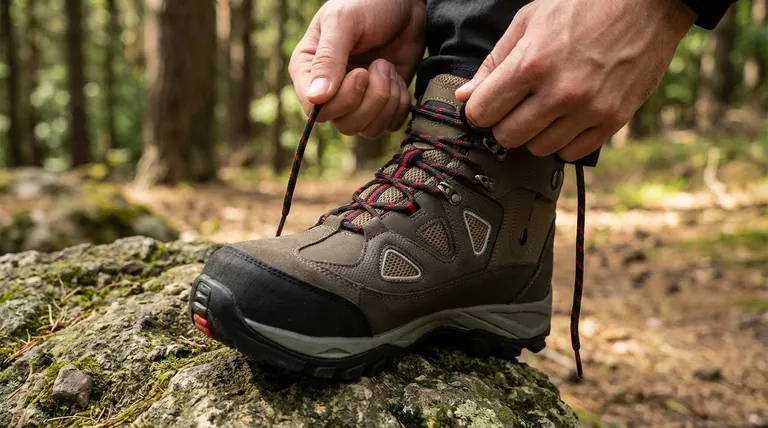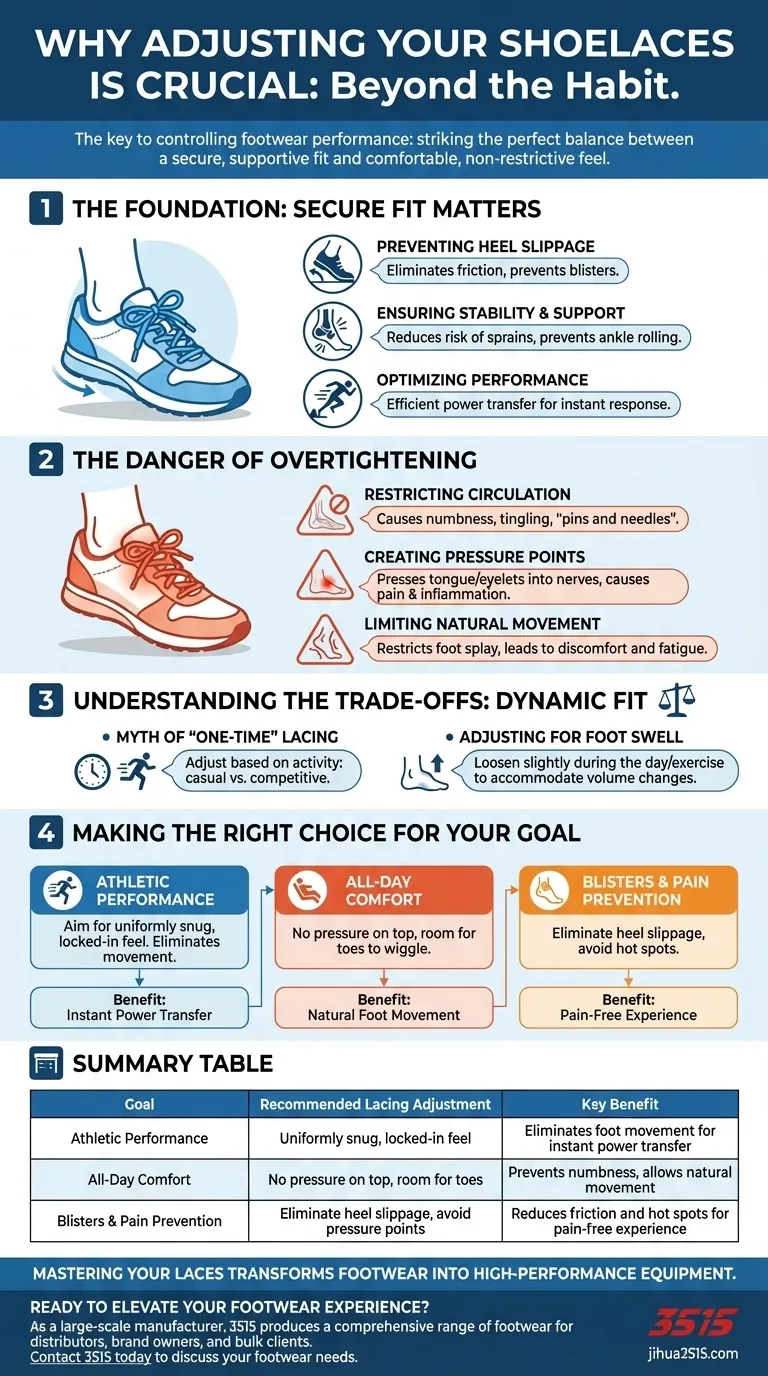The way you tie your shoes is more than just a habit; it is the single most important adjustment for controlling how your footwear performs. Properly adjusted laces are critical for striking the perfect balance between a secure, supportive fit that prevents slipping and a comfortable feel that doesn't restrict blood flow or cause pain.
The primary goal of adjusting your laces is not just to keep the shoe on your foot, but to customize the shoe's volume and shape to match your specific foot anatomy and intended activity. This directly impacts comfort, stability, and performance.

The Foundation: Why a Secure Fit Matters
A shoe that is not properly secured to your foot cannot provide the support it was designed for. Achieving a snug, but not tight, fit is the foundation of both comfort and safety.
Preventing Heel Slippage
When laces are too loose, your heel can lift and slide inside the shoe with every step. This constant friction is a primary cause of painful blisters and irritation on the back of your heel.
Ensuring Stability and Support
A well-laced shoe integrates with your foot, providing crucial lateral support. This stability helps prevent your ankle from rolling, reducing the risk of sprains during dynamic movements or on uneven ground.
Optimizing Performance
For any athletic activity, a secure fit ensures efficient power transfer. Whether you're pushing off for a sprint or changing direction on a court, a locked-in feel means the shoe responds instantly to your movements.
The Danger of Overtightening
Many people try to solve looseness by simply pulling their laces as tight as possible. This approach often creates more problems than it solves.
Restricting Circulation
The most common issue with overtightening is cutting off circulation to the foot. This can lead to numbness, tingling, or a "pins and needles" sensation, especially during extended wear.
Creating Pressure Points
Excessive tension can create "hot spots" by pressing the shoe's tongue and eyelets into the sensitive nerves and tendons on the top of your foot. This can lead to significant pain and even inflammation.
Limiting Natural Foot Movement
Your foot is designed to flex and splay naturally as you walk or run. A constricting fit limits this essential movement, leading to discomfort and fatigue over time.
Understanding the Trade-offs: Snug vs. Constricting
The ideal lace tension is a moving target, not a fixed point. It requires listening to your body and understanding the dynamic nature of your feet.
The Myth of "One-Time" Lacing
The perfect tightness for a casual walk is likely too loose for a competitive run. You should think of your laces as an adjustable part of your equipment, to be modified based on your activity.
Adjusting for Foot Swell
Feet naturally swell throughout the day, especially during exercise or in hot weather. A shoe that felt perfect in the morning may need to be slightly loosened in the afternoon to accommodate this change in volume.
Listening to Your Feet
Your body provides clear feedback. If you feel your heel moving, tighten the laces at the upper eyelets. If the top of your foot feels numb or pained, you have overtightened them.
Making the Right Choice for Your Goal
Ultimately, how you adjust your laces depends on what you want to achieve. Use your goal as a guide to find the perfect balance.
- If your primary focus is athletic performance: Aim for a uniformly snug, locked-in feel that eliminates all internal foot movement without causing any numbness or tingling.
- If your primary focus is all-day comfort: Ensure there is no significant pressure on the top of your foot and that you have enough room to wiggle your toes freely.
- If your primary focus is preventing blisters or pain: Concentrate on eliminating heel slippage while ensuring no single lacing crossover is creating a specific "hot spot" of pressure.
Mastering your laces transforms your footwear from a simple covering into a piece of high-performance, personalized equipment.
Summary Table:
| Goal | Recommended Lacing Adjustment | Key Benefit |
|---|---|---|
| Athletic Performance | Uniformly snug, locked-in feel | Eliminates foot movement for instant power transfer |
| All-Day Comfort | No pressure on top of foot, room for toes | Prevents numbness and allows for natural foot movement |
| Blisters & Pain Prevention | Eliminate heel slippage, avoid pressure points | Reduces friction and hot spots for a pain-free experience |
Ready to elevate your footwear experience? The perfect fit starts with the right shoe. As a large-scale manufacturer, 3515 produces a comprehensive range of footwear for distributors, brand owners, and bulk clients. Our production capabilities encompass all types of shoes and boots, ensuring you get the perfect combination of design, durability, and fit for your customers.
Contact 3515 today to discuss your footwear needs and discover how our expertise can bring superior comfort and performance to your product line.
Visual Guide

Related Products
- Safety Footwear Wholesale Manufacturer for Custom OEM/ODM Production
- Durable Rubber-Soled Utility Shoes for Wholesale & Custom Brand Manufacturing
- Wholesale Breathable Athletic Sneakers - Custom Lightweight Cushioned Footwear Manufacturer
- Premium KPU Injection Athletic Style Safety Shoes
- Premium Wholesale Tactical Style Safety Shoes Boots with Quick Lacing
People Also Ask
- How do safety shoes contribute to cost savings for companies? A Strategic Investment in Risk and Cost Management
- Is it normal to wear shoes in the house? A Guide to Hygiene, Comfort & Culture
- How long can you wear safety boots? The Lifespan is Determined by Wear, Not Time
- Is safety-toe as good as steel toe? Choose the Right Protection for Your Job
- What are the differences between steel toe, composite toe, and alloy toe Wellington boots? Choose the Right Safety Toe for Your Job



















